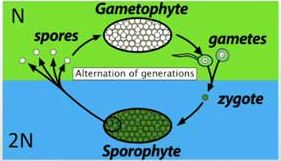Hapliod spore is the first cell of gametophic generation. It’s performed by the following steps:
(a) Formation of prothallus:
Each spore (n) germinates in favorable condition and forms a 3-6 celled protonema like structure which eventually gives rise to a heart shaped prothallus through repeatedly mitosis division.
The prothallus produces two types of reproductive organs
- Archegoniurn (n) and
- Antheridiurn (n).
Archegonium (n): It’s flask shaped and produces a single ovum (n)
Antheridiurn (n): It s round shaped and gives rise to numerous sperms.

(b) Fertilization:
(i) The matured sperms come out breaking down the antheridium wall.
(ii) The multiflagellated sperms swim to archegonium but only a single sperm fertilizes the ovum (n) entering the venter through the neck canal.
(iii) A zygote (2n) is formed due to fertilization (n+n).
As soon as zygote (2n) is formed, gametophytic generation (n) ends and sporophytic generation (2n) starts.
Formation of embryo (2n): Embryo is formed from zygote (2n) by means of mitosis divisions. A complete fern plant is formed later from the embryo through repeated mitosis division.
From the above discussion, it is found that alternation of generation is performed clearly in the life cycle of a fern plant through the repetition of gametophytic (n) and sporophytic (2n) generation alternately with each other.











